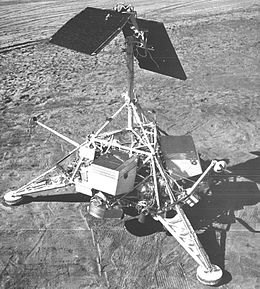This article needs additional citations for verification. (May 2020) |
 Surveyor model on Earth | |
| Mission type | Lunar lander |
|---|---|
| Operator | NASA |
| COSPAR ID | 1966-045A |
| SATCAT no. | 02185 |
| Mission duration | 7 months, 8 days (launch to last contact) |
| Spacecraft properties | |
| Manufacturer | Hughes Aircraft |
| Launch mass | 995.2 kilograms (2,194 lb)[1] |
| Landing mass | 292 kilograms (644 lb) |
| Start of mission | |
| Launch date | May 30, 1966, 14:41:01 UTC |
| Rocket | Atlas LV-3C Centaur-D AC-10 |
| Launch site | Cape Canaveral LC-36A |
| End of mission | |
| Last contact | 7 January 1967 |
| Lunar lander | |
| Landing date | June 2, 1966, 06:17:36 UTC[2] |
| Landing site | 2°28′26″S 43°20′20″W / 2.474°S 43.339°W[2] |
Surveyor 1 was the first lunar soft-lander in the uncrewed Surveyor program of the National Aeronautics and Space Administration (NASA, United States). This lunar soft-lander gathered data about the lunar surface that would be needed for the crewed Apollo Moon landings that began in 1969. The successful soft landing of Surveyor 1 on the Ocean of Storms was the first by an American space probe on any extraterrestrial body,[3] occurring on the first attempt and just four months after the first soft Moon landing by the Soviet Union's Luna 9 probe.
Surveyor 1 was launched May 30, 1966, from the Cape Canaveral Air Force Station at Cape Canaveral, Florida, and it landed on the Moon on June 2, 1966. Surveyor 1 transmitted 11,237 still photos of the lunar surface to the Earth by using a television camera and a sophisticated radio-telemetry system.
The Surveyor program was managed by the Jet Propulsion Laboratory, in Los Angeles County, California, and the Surveyor space probe was built by the Hughes Aircraft Company in El Segundo, California.
- ^ "Surveyor 1". NASA's Solar System Exploration website. Retrieved December 2, 2022.
- ^ a b Cite error: The named reference
NASAwas invoked but never defined (see the help page). - ^ "Chandrayaan-2 landing: 40% lunar missions in last 60 years failed, finds Nasa report". 7 September 2019.